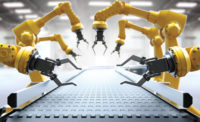Can you imagine a robot taking product from a refrigerated warehouse and transporting it to the packaging room? Can you also imagine the product not touching any human hands for a majority of this production process? While it may seem a bit futuristic for some companies, to OSI Group, it’s just another day at the West Jordan, Utah, plant.
That’s because this 101,000-square-foot plant gives a whole new meaning to state-of-the-art. One half of this facility runs virtually hands-free thanks to four robots who perform all of the heavy lifting. Couple the futuristic automation with extensive on-site food safety measures, and it’s easy to see why OSI Group, LLC, Aurora, Ill., received Refrigerated & Frozen Foods’ 2014 Refrigerated Foods Processor of the Year award.
The future is now
The West Jordan facility is broken down into two segments—the older plant, sitting at 50,000 square feet, that produces raw materials and cook-in-bag products for foodservice; and the newer plant, 51,000 square feet, that produces pepperoni, hard salami and Genoa salami. Both plants share a wall and a 5-door receiving dock, however they operate independently.
At the time of Refrigerated & Frozen Foods’ visit, the dry sausage plant was producing Genoa salami and pepperoni.
The newly redesigned dry sausage side is equipped with 2,800 underground magnets that steer the four robots along “highways” in the hallways. Each day, the robots are programmed to complete certain tasks. First, a robot takes an empty rack down to the stuffing room, where it loads up its 18-foot-tall rack with product and then travels to the cookhouse.
The meat undergoes the fermentation and cooking processes, and then robots transport it to one of the 15 drying houses (the first five cook, steam cook and dry and the other 10 just dry, no steam involved), where it spends its first weeks of life. Once the product achieves its necessary water activity level, moisture protein ratio (MPR) and other quality attributes, the drying houses convert to 32°F chillers.
“The drying houses rely heavily on ammonia refrigeration,” says Allen Forkell, Jr., operations manager, dry sausage. “You have conditioned air that comes out of the supply ducts to the product causing it to release moisture. That moisture rises up through the returns, goes against the cold coil, drops off the water, goes through a heating coil and then back out through the supply ducts. It just kind of keeps going through this process until the product dries. So, if we fill up one of these houses with 100,000 pounds of meat, at 14 days we could drop about 30,000 pounds of water.”
After the drying houses, the robots transport product into the ready-to-eat (RTE) production area, where it loads the rack up to a spiral transporter that spins around and empties the rods one by one. Dry sausage logs convey down into the processing area, where they come in contact with human hands for the first time. Here, operators manually check diameter, color and other quality control facets before placing the product onto a conveyor where the clips and loop are mechanically removed. The product then transports into an x-ray metal detection system. If it’s a good sausage, it’ll continue onward; if it’s a bad sausage, it’ll empty into a tub to be reviewed by QA.
Dry sausage then shuttles down onto a scale that prints off an inventory ticket, complete with an ingredient statement, weight, production date, etc., sticks it on the box and pushes it into the docking area.
Each rack is numbered with a computer-generated tag that outlines where it’s been, what rooms it was in, how much product is on the rack, where it’s going, when the task was completed, etc.
“The robots are great for QA tracking,” says Forkell. “It’s not like some of the older plants where you have big coolers or drying rooms that you push meat into trolley systems or with forklifts where tags may fall off or the product is hand-loaded onto other racks. This can possibly compromise the tracking system, and can lead to not knowing where the meat is or when it was placed in the cooler. Here, we know where things are 24/7.”
The robots handle about 3,500 pounds of product at one time and come equipped with photo eyes on both sides, kickplates all around and garage door openers to get in and out of the drying rooms.
“We keep the doors closed to lock in the temperature,” Forkell says. “We also keep the lights off to help prevent oxidation. The robots don’t need lights to work.”
The robots then hook themselves up to one of the four charging stations to re-charge when needed. The robots also feature sensors, so if the product starts swinging on the racks too much while in transport, the robot will slow down its speed and steady the product before moving on.
On the raw side of the newer plant, product shuffles in to a grinder that dumps out onto a conveyor and into a blender with spices, seasonings and other ingredients for 3-4 minutes. Blended meat conveys into one of two vacuum stuffers that stuff meat into shirred casings and applies two end clips and a hanging loop. The logs then convey under an x-ray machine that detects metals, foreign objects, etc.
Additional QC checks involve operators manually checking sausages for length, width and diameter while also checking the clips for tightness tolerance.
“We do a quality control test every 20 minutes, which consists of four different checks,” Forkell says. “The machine operator, QC technician, line lead and production supervisor perform checks on the product and enter the results in the database.”
After the sausage exits the x-ray machine, it is hung on the racks, nine sausages to a rod. This is the last time the product is touched by human hands. Then, a robot picks up eight rods (about 72 sausages) and puts them into one of the 18-foot-tall racks. Once the rack is full, it automatically transports to the cookhouse. The robot also captures intricate data, such as the weight, the process order, times it picked up the racks and times it placed the racks in the houses, etc., and downloads it into the facility’s computer system.
Cook-in-bag takes over
On the other side of the plant is the raw section, which produces barbacoa beef, pork carnitas and steak for foodservice.
At the time of Refrigerated & Frozen Foods’ visit, the 50,000-square-foot facility was producing 4,500 pounds of cooked barbacoa beef per hour along two production lines. The steak line runs five days a week with no line alterations.
Operators manually trim the barbacoa beef down to 0.25 inches and then pack it in 5-pound cook-in-bag pouches that travel through an x-ray system, which checks for bones, metal, glass, etc. Then, the pouches run through a flattener that helps pre-shrink the package for the restaurant. From there, operators manually place the pouches on cook racks that hold roughly 1,500 pounds of meat per rack.
The meat racks are manually pushed into the cooking room, where a remote wireless crane picks up the pouches and places them into one of the eight cooking and/or chilling tanks. Barbacoa cooks for six hours at 192°F, then chills for three hours at 33°F.
Once the beef is cooked and cooled, the crane picks out the pouches and places them in cases that convey to the docking area, where they are ticketed and entered into the company’s computer system.
“We have spent $5 million on projects, and every little detail out there is part of the customer relationship management,” says John Kelly, operations manager for the raw side. “This is a skilled labor job, not for just anybody off the street. These operators pay close attention to detail and have excellent trimming skills.”
The $5 million upgrade also boasts a state-of-the-art bone elimination system.
“We have partnered with a company to develop an x-ray system that is capable of screening our raw materials before they are ground, thus detecting and removing foreign objects while they are larger and easier to find—and before they are ground into a million pieces,” says Larry Glaser, assistant vice president and director of operations and process improvement. “The benefits of the system include improved food safety, customer satisfaction and reduced equipment damage and downtime that may have resulted due to large objects entering the equipment. Most importantly though is the fact that we can screen product before blending it, so we can maintain the supplier identification on the results. We can show our suppliers, teach our suppliers and now hold them accountable for the defects we find in their product. This helps drive improvement and integrity, and in many cases, provides us with the data needed to make the best purchasing decisions for our raw materials.”
The West Jordan plant is also home to a leadership program, where some of the foremen get trained to move up the leadership ladder. (To learn more about some of the plant’s sustainability initiatives, go to “MEAT-ing Customer Needs, Day In and Day Out.").
Between hands-free automation and technologically advanced food safety equipment, OSI and its West Jordan facility redefine “state-of-the-art.”
CLICK HERE to check out more photos from our plant tour.



















